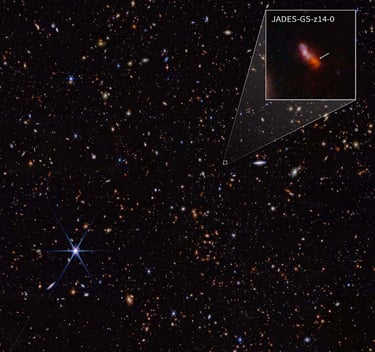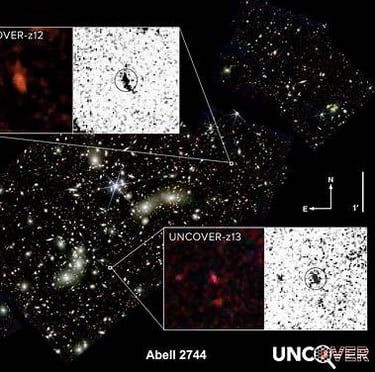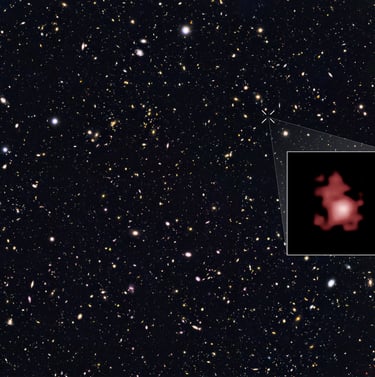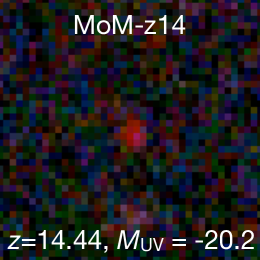How Webb's Galaxies Challenge Cosmic Expansion
7/22/20258 min read


Hypothesis: Is redshift truly evidence of the Universe expanding? Or could it be a completely natural phenomenon that has nothing to do with it?
Did Hubble see it right but understand it wrong?
Or was Zwicky right, and light simply fades away?
The early decades of the 20th century brought a wave of discoveries: from the cosmic background radiation and a new definition of gravity in general relativity, to evidence that our Milky Way is not the only galaxy in the Universe. A key figure in this scientific breakthrough was Edwin Hubble.
Alongside these discoveries came many bold theories, one of which was proposed by Belgian priest and scientist Georges Lemaître. In 1927, based on Einstein's general relativity equations, Lemaître postulated that the Universe is not static and is most likely expanding. He brought his hypothesis to Einstein himself, who initially rejected it, claiming the Universe is and must be static. At the time, Einstein reportedly responded that if the equations suggested otherwise, then so much the worse for the equations. (In fact, he said what Lemaître proposed was a misunderstanding, but later, after Hubble's discoveries, he admitted Lemaître was right and called it his "biggest blunder" — referring to the cosmological constant he added to keep the Universe static.)
Independently of Lemaître, Edwin Hubble — after discovering that there were other galaxies beyond the Milky Way — began to study them in detail. For this purpose, he used the largest available telescope at the time: the 100-inch Hooker telescope at Mount Wilson Observatory.
During his observations, Hubble noticed that the light from most galaxies showed a redshift, which, according to the Doppler effect, suggested that these galaxies were moving away from us — and from each other.
To confirm his assumptions, Hubble used the method of measuring distances to galaxies via Cepheid variable stars, whose absolute brightness is known. By comparing their observed brightness to their intrinsic brightness, he could determine distances. By plotting these distances against the redshift values, he discovered a relationship: the farther away a galaxy is, the faster it appears to be receding. Thus, he formulated Hubble's Law.
Although the observations matched the prior hypotheses, Hubble hesitated to publish his results — unsure whether the issue was technical limitations or the strangeness of the phenomenon itself. Today, we know he was right. The Universe is expanding — and all evidence points to the rate of this expansion increasing.
But still — is everything we know about redshift solely a result of space expanding? Is it possible that Hubble wasn't wrong about the phenomenon, but that his interpretation was incomplete?
Already in the 1930s, Fritz Zwicky proposed an alternative concept: the "tired light" theory, which suggested that light loses energy during its journey through space, not because of galaxies moving, but due to interactions with matter or the structure of space itself. The effect: light reaches us redshifted, but without the need for expansion.
At the time, Zwicky's hypothesis was rejected, mainly because it did not explain time dilation observed in distant supernovae and did not predict the observed spectrum of background radiation. However, today — thanks to modern telescopes such as the James Webb Space Telescope (JWST) — questions return about whether redshift might result from something other than expansion.
JWST was launched into orbit in December 2021, with its first observations released in mid-2022. Unlike Hubble, which observed mainly in visible and near-infrared light, Webb was designed to operate in the mid and far infrared (up to 28 micrometers). This allowed it to observe the oldest and most distant galaxies, whose light has been redshifted far beyond the visible range.
And here's where the problem for the expansion model arises: the most distant object discovered so far, the galaxy MoM-z14, dates back to about 280 million years after the Big Bang — and yet it possesses a developed structure and significant mass. This raises serious doubts about the classical model of galaxy formation, which suggests such objects should not exist so early in cosmic history. These are exciting findings — on one hand, the objects are indeed extremely distant, but on the other, their emission and structural properties support the hypothesis of spectral fading rather than classic spacetime stretching. Some of these galaxies — which were expected to be young and just forming — turned out to be complex, mature structures, larger than anticipated. This triggered a major crisis among cosmologists: how could such a young Universe host such mature galaxies? Is spacetime really expanding the way we think it is?
In light of these observations, an alternative hypothesis emerges: perhaps redshift is not due to motion or expansion, but rather to the suppression of high-frequency waves as the source gets further away. Just like the blue light of a candle flame fades faster than red in the atmosphere, so UV or visible light from distant galaxies fades faster than infrared or microwaves. What we interpret as a redshifted spectrum may actually be the result of selective energy loss in light waves.
In this view, background radiation may not be the leftover glow of the Big Bang, but simply the sum of the longest waves that survived billions of years of travel through space — the echo of light that is now too faint to be registered in the classical spectrum and visible only as microwaves. This would also explain why we only see some galaxies when their light is amplified — without such amplification, some objects are simply too faint to be observed.
All of this leads to one inconvenient conclusion: Moreover, observations lack clear signs of angular displacement (parallax) for receding galaxies. If they were truly moving within expanding space, they should show at least minimal lateral motion over time — yet this is not observed. This challenges the "balloon model" and supports the interpretation that light waves weaken and fade rather than being stretched.
Observations from James Webb and prior experiments also confirm that shorter waves (like ultraviolet) have much shorter range than longer ones (like infrared and microwaves). A good analogy is the simple candle experiment: blue light disappears within a few meters, while red remains visible farther. On a cosmic scale, this could mean that UV spectra from distant galaxies simply do not reach us — not because of stretching, but because they faded away. A visual confirmation of this is the fact that in distant galaxies, whose internal rotation is greater than their receding velocity, we do not observe the expected local blueshift in one of their parts — though we should. This effect, however, is visible in nearby galaxies, where spectral differences due to rotation are measurable. This suggests that shorter waves fade with distance before reaching our instruments.
Spectrum stretching and fading of light bands are two different phenomena. The first assumes the wave is deformed by expanding space. The second — that light simply stops being detectable at higher energies, leaving only low-frequency components.
It is also worth noting that the James Webb Telescope was expected to confirm the standard cosmological model — and instead, its data revealed something entirely different: mature, massive galaxies where only forming structures were expected. This can be read as an unintended proof that the accepted interpretation of redshift might be incorrect. Moreover, it is no coincidence that blueshifted galaxies are observed as the closest, and redshifted ones as the most distant. Observations also show that the farther a galaxy is, the faster it appears to recede — which the classical interpretation links to accelerated cosmic expansion. Yet this matches wave behavior: the longer the wavelength, the farther it can travel. As a result, the spectrum stretches, and shorter waves gradually disappear, which may be a simple propagation effect rather than space expansion. Maybe it's not the Universe that is expanding, but rather light's spectrum that fades away with distance. Perhaps spacetime doesn't need to stretch for light waves to change. And maybe — most fascinating of all — the tired light theory wasn't wrong, just premature.
The discovery and Hubble’s law were undoubtedly revolutionary and innovative for their time. The methods he used back then still inspire admiration today — although from today’s perspective we know that they were not as precise as modern standards require. The pressure from the scientific community, which was increasingly leaning toward the idea of an expanding Universe, eventually forced Hubble to publish his findings. However, with them came the need to “patch” the new model — and so another concept entered the game: dark energy. It is precisely dark energy that is supposed to be responsible for the observed acceleration of the Universe’s expansion. According to current cosmology, it constitutes as much as 68% of the total energy content of the Universe — even though it has never been directly observed. It is a purely hypothetical concept, derived only from equations that must match the recorded redshift. But if redshift may have completely different causes than expansion, then the entire construction of dark energy may also turn out to be an illusion — a mathematical workaround created to fit the data to the assumed model. It is truly surprising that something that is supposed to have such a powerful impact on the entire structure of the Universe remains invisible. And yet — it is “seen” only in equations.
Summary:
In Hubble’s time, technology wasn’t advanced enough for his observations to definitively prove that the Universe was expanding. Too many data points were missing, and our understanding of the nature of light was extremely limited. Today, we know much more—and what we know urges us to look back with a sense of regret.
It’s truly unfortunate that such incredible instruments as the James Webb Space Telescope operate based on principles that clearly challenge existing models—and yet their discoveries are bent or marginalized, just to avoid disturbing the foundations of old theories—often more hypotheses than scientific facts, and now over a century old.
It’s almost unbelievable how authority can turn science into something resembling religion—defended at all costs, even at the expense of truths revealed directly through observation.
In the next article, we will describe the magnetic fields of celestial bodies, in which we will further expose how modern science patches crumbling models—either ignoring observations or inventing strange entities just to fit them into the old framework.


JADES (NIRCam Image with Pullout). The NIRCam data was used to determine which galaxies to study further with spectroscopic observations. One such galaxy, JADES-GS-z14-0 (shown in the pullout), was determined to be at a redshift of 14.32 (+0.08/-0.20), making it the current record-holder for the most distant known galaxy. This corresponds to a time less than 300 million years after the big bang. Get the JADES image details and downloads. Credit: NASA, ESA, CSA, STScI, B. Robertson (UC Santa Cruz), B. Johnson (CfA), S. Tacchella (Cambridge), P. Cargile (CfA).


The second- and fourth-most distant galaxies ever seen (UNCOVER z-13 and UNCOVER z-12) have been confirmed using the James Webb Space Telescope’s Near-Infrared Camera (NIRCam). The galaxies are located in Pandora’s Cluster (Abell 2744), show here as near-infrared wavelengths of light that have been translated to visible-light colors. The scale of the main cluster image is labelled in arcseconds, which is a measure of angular distance in the sky. The circles on the black-and-white images, showing the galaxies in the NIRCam-F277W filter band onboard JWST, indicate an aperture size of 0.32 arcsec. Source: Eurekalert.org


GN-z11 – a galaxy discovered in 2016, which was considered the most distant confirmed object from Earth until the discovery of galaxy HD1.
Source: Wikipedia


